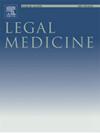基于死后计算机断层扫描的脑分解评估:与死后间隔和死因确定的相关性。
IF 1.4
4区 医学
Q3 MEDICINE, LEGAL
引用次数: 0
摘要
背景:准确估计死后时间间隔(PMI)对法医调查至关重要。在死后计算机断层扫描(PMCT)上观察到的脑分解可能为估计PMI提供有用的标记;然而,这种方法还没有得到广泛的研究。本研究的目的是利用PMCT结果对脑分解进行分类和量化,并调查其与PMI、死亡原因的可确定性和环境因素的关系。方法:回顾性分析176例尸检前PMCT病例。使用视觉PMCT结果将脑分解分为五个阶段,并使用轴向计算机断层扫描切片上的脑面积与长度比进行量化。使用相关和回归分析评估PMI与死亡原因可确定性之间的关系。结果:脑分解阶段和定量指标与PMI有较强的相关性(ρ = 0.61 ~ - 0.69),对PMI≥7 ~ 60天具有较高的预测性能(曲线下面积[auc]: 0.904 ~ 0.984)。脑面积比值对PMI≥60天的预测准确率最高(AUC = 0.984,截断值≤60.7%)。未确定死因的死亡率从0期的7.1%上升到4期的92.9%。脑变形率与季节效应呈正相关(p = 0.0017)。结论:基于pmct的脑分解评估可为估计晚期pmi提供客观标记,并有助于评估腐烂尸体的死因可能性。本文章由计算机程序翻译,如有差异,请以英文原文为准。

Postmortem computed tomography-based evaluation of brain decomposition: Correlation with postmortem interval and cause-of-death determinability
Background
Accurately estimating the postmortem interval (PMI) is essential for forensic investigations. Brain decomposition observed on postmortem computed tomography (PMCT) may provide useful markers to estimate PMI; however, this approach has not been extensively studied. The aim of this study was to classify and quantify brain decomposition using PMCT findings and to investigate its association with PMI, determinability of cause of death, and environmental factors.
Methods
We retrospectively analyzed 176 adult autopsy cases involving preautopsy PMCT. Brain decomposition was classified into five stages using the visual PMCT findings and quantified using brain area-to-length ratios on axial computed tomography slices. Associations between the PMI and determinability of the cause of death were assessed using correlation and regression analyses.
Results
Brain decomposition stage and quantitative indices showed strong correlations with PMI (ρ = 0.61 to − 0.69), with high predictive performance for estimating PMI ≥ 7–60 days (area under the curves [AUCs]: 0.904–0.984). Brain area ratio showed the highest accuracy for estimating PMI ≥ 60 days (AUC = 0.984, cutoff ≤ 60.7 %). The rate of undetermined causes of death increased from 7.1 % in stage 0 to 92.9 % in Stage IV. Brain deformation ratio was positively correlated with seasonal effects (p = 0.0017).
Conclusion
PMCT-based assessment of brain decomposition may provide objective markers for estimating late PMIs and assist in evaluating the likelihood of cause-of-death in decomposed bodies.
求助全文
通过发布文献求助,成功后即可免费获取论文全文。
去求助
来源期刊

Legal Medicine
Nursing-Issues, Ethics and Legal Aspects
CiteScore
2.80
自引率
6.70%
发文量
119
审稿时长
7.9 weeks
期刊介绍:
Legal Medicine provides an international forum for the publication of original articles, reviews and correspondence on subjects that cover practical and theoretical areas of interest relating to the wide range of legal medicine.
Subjects covered include forensic pathology, toxicology, odontology, anthropology, criminalistics, immunochemistry, hemogenetics and forensic aspects of biological science with emphasis on DNA analysis and molecular biology. Submissions dealing with medicolegal problems such as malpractice, insurance, child abuse or ethics in medical practice are also acceptable.
 求助内容:
求助内容: 应助结果提醒方式:
应助结果提醒方式:


